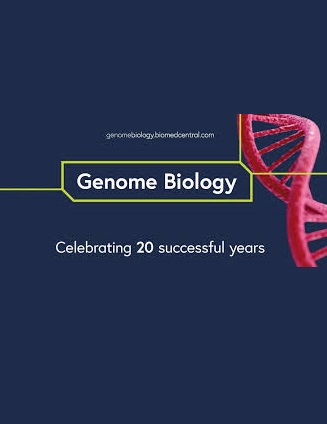Spatiotemporal modeling reveals high-resolution invasion states in glioblastoma
IF 10.1
1区 生物学
Q1 BIOTECHNOLOGY & APPLIED MICROBIOLOGY
引用次数: 0
Abstract
Diffuse invasion of glioblastoma cells through normal brain tissue is a key contributor to tumor aggressiveness, resistance to conventional therapies, and dismal prognosis in patients. A deeper understanding of how components of the tumor microenvironment (TME) contribute to overall tumor organization and to programs of invasion may reveal opportunities for improved therapeutic strategies. Towards this goal, we apply a novel computational workflow to a spatiotemporally profiled GBM xenograft cohort, leveraging the ability to distinguish human tumor from mouse TME to overcome previous limitations in the analysis of diffuse invasion. Our analytic approach, based on unsupervised deconvolution, performs reference-free discovery of cell types and cell activities within the complete GBM ecosystem. We present a comprehensive catalogue of 15 tumor cell programs set within the spatiotemporal context of 90 mouse brain and TME cell types, cell activities, and anatomic structures. Distinct tumor programs related to invasion align with routes of perivascular, white matter, and parenchymal invasion. Furthermore, sub-modules of genes serving as program network hubs are highly prognostic in GBM patients. The compendium of programs presented here provides a basis for rational targeting of tumor and/or TME components. We anticipate that our approach will facilitate an ecosystem-level understanding of the immediate and long-term consequences of such perturbations, including the identification of compensatory programs that will inform improved combinatorial therapies.时空建模揭示胶质母细胞瘤的高分辨率侵袭状态
胶质母细胞瘤细胞通过正常脑组织的弥漫性侵袭是导致肿瘤侵袭性、对传统疗法的抗药性和患者预后不良的关键因素。更深入地了解肿瘤微环境(TME)的组成成分如何促进整体肿瘤组织和侵袭程序,可能会为改进治疗策略带来机遇。为了实现这一目标,我们将一种新颖的计算工作流程应用于时空剖析的 GBM 异种移植物队列,利用区分人类肿瘤和小鼠 TME 的能力来克服以前在分析弥漫性侵袭方面的局限性。我们的分析方法以无监督解卷积为基础,在完整的 GBM 生态系统中对细胞类型和细胞活动进行无参照发现。我们在 90 种小鼠大脑和 TME 细胞类型、细胞活动和解剖结构的时空背景下,提出了 15 种肿瘤细胞程序的综合目录。与侵袭有关的不同肿瘤程序与血管周围、白质和实质侵袭的途径一致。此外,作为程序网络枢纽的基因亚模块对 GBM 患者的预后具有高度预测作用。本文介绍的程序汇编为合理靶向肿瘤和/或TME成分提供了基础。我们预计,我们的方法将有助于在生态系统层面上了解这种干扰的直接和长期后果,包括确定补偿程序,为改进组合疗法提供依据。
本文章由计算机程序翻译,如有差异,请以英文原文为准。
求助全文
约1分钟内获得全文
求助全文
来源期刊

Genome Biology
Biochemistry, Genetics and Molecular Biology-Genetics
CiteScore
21.00
自引率
3.30%
发文量
241
审稿时长
2 months
期刊介绍:
Genome Biology stands as a premier platform for exceptional research across all domains of biology and biomedicine, explored through a genomic and post-genomic lens.
With an impressive impact factor of 12.3 (2022),* the journal secures its position as the 3rd-ranked research journal in the Genetics and Heredity category and the 2nd-ranked research journal in the Biotechnology and Applied Microbiology category by Thomson Reuters. Notably, Genome Biology holds the distinction of being the highest-ranked open-access journal in this category.
Our dedicated team of highly trained in-house Editors collaborates closely with our esteemed Editorial Board of international experts, ensuring the journal remains on the forefront of scientific advances and community standards. Regular engagement with researchers at conferences and institute visits underscores our commitment to staying abreast of the latest developments in the field.
 求助内容:
求助内容: 应助结果提醒方式:
应助结果提醒方式:


